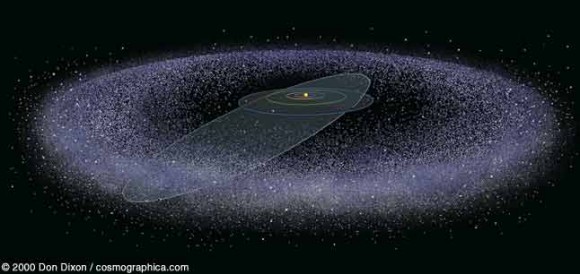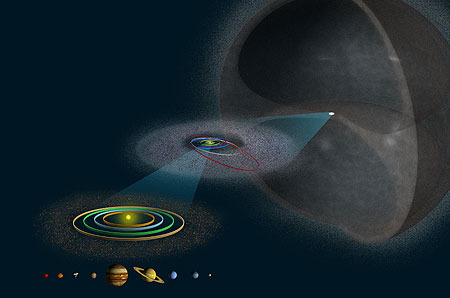by Tom Stephens
|
Editor's Note: This is the first of many articles that will give basic introduction to the real science behind a number of astronomical topics. The idea is to present a short description of the objects or phenomenon and discuss how it might impact your game setting. While you always have the option to incorporate the real world nature of these topics or ignore them, having a good grounding in the real science can improve the quality of your "technobabble" if you prefer a more fantastic sci-fi setting. |
Introduction
Both the Oort Cloud and the Kuiper Belt (officially called the Edgeworth-Kuiper Belt) are systems of objects in the outer solar system. While the names Oort Cloud and Kuiper Belt specifically refer to the systems here in our solar system, similar systems are expected to exist in any stellar system. The names refer to the astronomers who first hypothesized their existence.
They are composed of objects ranging in size from a few thousand kilometers in diameter (i.e. Pluto) down to meter sized objects and smaller. In both cases, the objects in these systems are composed mostly of ices (water, methane, and ammonia) with a bit of rocks and other minerals mixed in. They are made of material that was left over from the formation of the stellar system. Scientifically, they represent the primordial material the planets were made from. The exact classification of an object as a member of either system depends completely on its location and orbit.
Location, Location, Location
|
Artist's representation of the Kuiper Belt. The orbits of the outer planets are included for scale. The narrow elongated orbit is Pluto. |
The Kuiper Belt is the closer of the two systems. In our solar system it starts at a distance of about 30 AU (just outside Neptune's orbit) and extends out to 55 AU from the Sun. It is a disk shaped distribution with objects mostly confined to the plane of the solar system (lined up with the major planets) although the distribution of inclinations is much larger than those of the planets. For example, while the planet with the largest inclination is Mercury at about 7 degrees, Kuiper Belt objects can have inclinations relative to the plane of the solar system of up to 20 to 30 degrees (Pluto's inclination is ~17 degrees).The Oort cloud is really composed of two parts: the inner Oort Cloud and the outer Oort Cloud. The inner Oort cloud is much like the Kuiper Belt, it is a disk shaped distribution of material that lies mainly in the plane of the solar system. The only difference is its distance. Objects in the inner Oort Cloud have distances from the sun that range from 2,000 to 20,000 AU. The outer Oort Cloud, unlike the other two, is a spherical distribution, basically a giant shell around the star. It ranges in distance from 20,000 to 50,000 AU or 0.79 light years (although some estimates put the outer edge as far away as 100-200 thousand AU). It should be noted that the Oort Clouds are completely hypothetical as no Oort cloud object has ever been observed in its "native habitat". However, objects that are believed to be from the Oort Cloud have been observed as long-period comets.
Just How Much Stuff Is Out There?
| Relative sizes of the Kuiper Belt and Oort Cloud. At the bottom left is the inner solar system, the middle image is the outer solar system and the Kuiper belt and the final image is the Oort Clouds. Both the inner Oort Cloud (the disk shaped region along the center) and the outer Oort Cloud (the spherical shell) can be seen. |
While large objects such as Pluto are fairly rare, the number of objects increases rapidly as the size decreases. In total, the Kuiper Belt probably contains hundreds of thousands of objects greater than 100 km in diameter and over a trillion objects overall. Despite this, the total mass in the Kuiper belt is quite low, only about 0.04 to 0.10 times the mass of the earth. The Oort cloud is larger and is estimated to contain several trillion objects larger than 1 km with a total mass estimated to be about five times that of Earth.
What does that mean for the chance of an encounter? Let's make some simplifying assumptions and do some quick math. Let's assume that all of the objects in the Kuiper Belt are arranged in a curtain at 30 AU and extend 20 degrees above and below the plane of the stellar system and are evenly spaced throughout the curtain. In truth they are arranged randomly in three dimensions and extend up to 30 degrees (but are more concentrated at the lower inclinations) but this gives a good approximation of encountering something as you traverse the entire belt.
The total surface area of that "curtain" is 4.35x1019 (43.5 billion billion) square kilometers. Given those trillion objects in the Kuiper Belt greater than 1 m, that means that the average distance between any two objects in our "curtain" Kuiper Belt is about 7500 km and each object has 43.5 million square km of the "curtain" to itself. In the real Kuiper Belt, the three dimensional distances are millions of times larger. What this means is that if you set out in a random direction, and even if your ship was a square kilometer in cross section, your chance of actually hitting something after traversing the entire thickness of the Kuiper belt is about 1 in 43.5 million. Since ships are typically smaller than that (on the order of 1000's of square meters in cross section) the probably is really a factor of 10-100 times smaller.
The Oort Cloud, while containing more objects, covers and even greater area and is even less dense on average than the Kuiper Belt.
Impact on Your Game
The exact impact the Kuiper Belt and Oort clouds have on your game really depends on the speed and methods of space travel. The easier it is to get out there the more of an impact these systems could have on your setting.
In-system Uses
For campaigns with slow real-space travel, the prospects of actually getting out to the Kuiper Belt or Oort Cloud are really small. The time involved is just too large, on the order of months, years, or decades in order to get out that far. Remember that NASA's New Horizons mission, the fastest space craft we ever launched, will still have taken 9 years to travel from Earth out to Pluto (38 AU from the sun) when it arrives in 2015. Unless the exploration of one of these objects is the focus of the game, PC's are probably not going to be willing to take the time out of their lives to get out there. There are other things more exciting than exploring an empty, dirty snowball.
In this situation, these objects are mostly of interest to the scientific community. For the most part they are too far out to really be useful as bases. Even though the light travel time (i.e signal delay) from the inner system to the inner portions of the Kuiper Belt is only about 5-6 hours, and it might be conceivable that an enemy would set up a listening post out there to monitor the system, the issue of getting out there to resupply the base would be a serious problem and not really feasible.
On the other hand, as the time required to get out to these distances decreases, their usefulness for mining, research, bases, and whatnot increases. When travel times can be measured in hours, days, or even weeks, they become usable real estate and resource locations. There will be scientific labs, military bases, criminal hideouts, and mining operations all operating out in these areas.
For example, in Star Frontiers, where the maximum speed is limited to 0.01 times the speed of light by the game mechanics, it would take about 27 days to make a 40 AU journey out to the Kuiper Belt. The first 4 days would be spent accelerating at 1g to just under 0.01c. Then the ship would coast at that speed for about 19 days and then flip around and start decelerating for the next 4 days until they came to a stop at their destination. If the 0.01c limit didn't exist, then the trip would take just under 18 days. In this case, they could accelerate constantly at 1 g to the halfway point (reaching a top speed of 0.0258c, 7745 km/s), flip over and then decelerate at 1 g to their destination. Obviously ships capable of higher accelerations (and thereby greater speeds) would take even less time. These times are starting to approach those at which it might start to make sense to have bases and other activities in these areas.
Building a Base
|
An artist's concept of the Kuiper Belt Object Eris with its moon just above. The sun can be seen in the upper left corner. Credit: NASA, ESA, and A. Schaller (for STScI) |
If you do use Kuiper Belt or Oort Cloud objects as locations in your setting, there are some things to keep in mind as you design the base. First remember that these are cold, airless worlds on the fringes of the stellar systems. Bases will have to be sealed against vacuum much like a space craft or space station.
These bases will either be dug into, or built upon, cold, icy terrain. An outpost in the Kuiper Belt or Oort Cloud will have to be well insulated. On a spacecraft, the problem is getting rid of excess heat. Vacuum is the perfect insulator, the ice of these worlds, on the other hand, will gladly conduct away the heat from your systems Here the problem will be both keeping the heat in where you want it as well as releasing excess heat properly (and not melting the surrounding ice!)
In addition to accidentally melting your surroundings, the objects themselves may or may not be structurally stable. The ice and rock mixture that makes up these objects is expected to be riddled with fractures and sudden changes in composition and density. Things may shift around and bases should be capable to responding to these kinds of events, especially as the presence on the object becomes large or extended.
Another issue to remember is the power source. Solar power won't work as these objects are simply too far away from their host star to generate any effective amount of energy by that method. Most likely they will be powered by some sort of nuclear power plant. And these power plants generate a lot of excess heat. Which brings you back once again to the issue of insulation and the controlled dissipation of heat to prevent melting the surroundings.
All of these items provide ideas to think about when designing the base but also provide potential adventure hooks and events that could occur at the base if the characters spend any amount of time there.
Issues for Interstellar Travel
At best, these objects are a plot device for the game master. Unless the game master wants to use them, they can pretty much be safely ignored. The number and density are just too low for them to realistically show up on even the most generous of random encounter tables. However, an encounter with one of these objects could potentially be catastrophic if not fatal depending on the parameters of the encounter.
In a game like Star Frontiers, where interstellar travel occurs via a jump through "the Void" or some sort of alternate reality, the Kuiper Belt and Oort Cloud pose no navigation hazard. The jump is made long before you reach the distances where these objects are found and you reenter the new system well inside these distances.
In a game system with hyperspace mechanics similar that used in Larry Niven's Known Space books, where the presence of a gravity well too close to the ship will cause some sort of problem, either causing the ship to be lost or dropping them out of hyperspace into "real" space, then these objects can pose a bit of a navigational hazard. For the most part, since these objects are small, you'd have to be practically on top of them before their gravity would be strong enough to have any influence. And that assumes that the object is even big enough to have a strong enough gravitational influence. However, some of the larger objects are the size of small planets and could pose a problem. The main danger is the fact that the vast majority, probably on the order of 99.99999% of these objects, are uncharted. The known ones are easy enough to avoid. It’s the ones that haven't been seen before that could be the problem.
The above is also true for systems that use a form of warp drive like in the Star Trek universe where ships move at faster than light speeds though real space. In this case the chance of an encounter is probably a little larger. While you practically have to hit the object instead of being influenced by its gravity well, there are many more small objects that you could interact with so the chance of encounter goes up. And, if there is an impact, especially at these high speeds, the results would be catastrophic, most likely resulting in complete destruction of the ship, unless the object was really small. But remember, the odds of that are very small, one the order of 1 in 43 million.
Final Comments
While Kuiper Belt and Oort Cloud objects are interesting, the impact on your game is probably small unless you want them to have one or your setting has very fast travel speeds. They are mostly fairly small and very much spread out in the outer system where travel times can be huge to just reach the closest ones. However, if you do include them in your game, they can provide real estate for a variety of installations and encounters.




